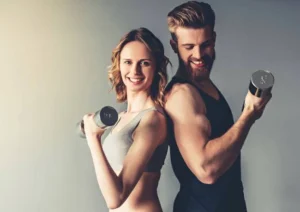What Workout for Biceps?
The Best Exercises for Bigger Stronger Arms
Introduction
If you’re hitting the gym to build some impressive biceps you’re not alone.
A lot of folks are looking to boost their strength or fill out their sleeves.
Getting your biceps workout right is super important. In this guide,
we’ll dive into the best biceps exercises proper form and some tips to help you grow stronger.
Why Focus on Biceps?
The biceps brachii is that muscle in the upper arm that helps with bending your elbow and rotating your forearm.
When you’ve got well-defined biceps your arms not only look better but you also perform better in pulling movements like rows and pull-ups.
Top 5 Best Biceps Workouts
1. Barbell Bicep Curl
How to Do It:
- Stand with your feet shoulder-width apart holding a barbell with your palms facing up.
- Keep your elbows tucked in against your body and curl the bar toward your chest.
- Slowly lower the bar back down.
Why It Works:
This classic move lets you lift heavy which is great for muscle growth by gradually increasing the weight.
2. Dumbbell Hammer Curl

How to Do It:
- Hold a dumbbell in each hand at your sides with your palms facing each other.
- Curl the weights up while keeping your wrists straight.
- Lower them back down slowly.
Why It Works:
This one targets the brachialis which sits under the biceps
and helps beef up your arms.
3. Chin-Ups
How to Do It:
- Grab a pull-up bar with your palms facing you and your hands shoulder-width apart.
- Pull yourself up until your chin goes above the bar.
- Slowly lower yourself down.
Why It Works:
Chin-ups work your biceps along with your back giving you strength that’s useful in everyday life.
4. Preacher Curl
How to Do It:
- Sit at a preacher bench with your arms resting on the pad.
- Curl either a barbell or dumbbells upwards then lower them back down.
Why It Works:
This isolates your biceps minimizing any shoulder action which helps you really focus on that muscle.
5. Concentration Curl
How to Do It:
- Sit on a bench and rest one elbow against your inner thigh.
- Curl the dumbbell toward your shoulder then lower it with control.
Why It Works:

This move really gets your biceps to contract fully giving you that maximum muscle activation.
Biceps Training Tips for Faster Growth
1. Focus on Form Over Weight
Using too much momentum takes away from working your biceps properly.
Lift with control for better results.
2. Incorporate Variety
Switch things up with barbells dumbbells and cables to hit your muscles from different angles.
3. Train Biceps 2-3 Times Weekly
Shoot for 3-4 sets of about 8-12 reps each time for muscle growth.
4. Prioritize Progressive Overload
Gradually increasing weight or reps will keep those biceps growing.
Common Mistakes to Avoid
- Swinging the Weights: This reduces how much you use your biceps.
- Partial Reps: You need full range of motion for real muscle gains.
- Overtraining: Give your biceps at least 48 hours to recover between workouts.
Conclusion
To pump up your biceps focus on mixing heavy lifts with isolation exercises.
Keep an eye on proper form and always be consistent.
Add these workouts into your routine and you’ll definitely notice growth in strength and size.
HOSTINGER HOSTING PLAN DISCOUNT CODE
